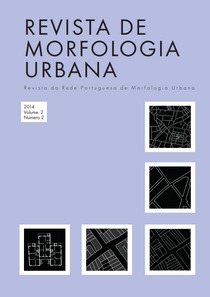Abstract
Climate change, and its consequences, points out the need of developing strategies for mitigating problems related to urban overheating. This paper aims to examine the influence of urban form, here measured by the Sky View Factor (SVF), on intra-urban temperature in the city of Glasgow, UK, a naturally cold city. A set of 49 measurement points was selected in the city centre, and 31 campaigns, for data collection, were made during the spring and summer of 2013. In order to cover a large area of the city, within a relatively short period of time, the ‘traverse’ method was used on pre-determined routes. Temperature variation was visualized using the software ArcGIS. The results indicate that the maximum intra-urban temperature differences are strongly correlated with atmospheric stability, which suggests that atmospheric stability has a relevant effect on intra-urban temperature variation. The study also indicates, as expected, that the vegetation and the urban cover materials play an important role in influencing the local climate in cold cities. The knowledge on the influence of urban form on local temperature variation can be important in the development of strategies to deal with urban overheating.
References
Amorim, M., Lima Neto, J. e Monteiro, A. (2013) Climatologia urbana e regional: questões teóricas e estudos de caso (Outras Expressões, São Paulo).
Chandler, A. J. (1965) The climate of London, (Hutchinson and Co, Londres).
Corbella, O. e Yannas, S. (2003) Em busca de uma arquitetura sustentável para os Trópicos: conforto ambiental (FAPERJ Revan, Rio de Janeiro).
Drach, P. R. C. (2007) Modelagem computacional e simulação numérica em arquitetura visando conforto em ambientes construídos. Tese de Doutoramento não publicada, Laboratório Nacional de Computação Científica, Brasil.
Greater London Authority, GLA (2006) London’s urban heat island: a summary for decision makers, (http://legacy.london.gov.uk/mayor/environment /climate-change /docs /UHI_summary_report.pdf) consultado em 31 de Dezembro de 2013.
Greater London Authority, GLA (2011) Managing risks and increasing resilience: the Mayor’s climate change adaptation strategy (http://www.london.gov.uk/priorities/environment /publications /managing-risks-and-increasing-resilience-the-mayor-s-climate) consultado em 31 de Dezembro de 2013.
Hebbert, M. e Jankovic, V. (2013) ‘Cities and climate change: the precedents and why they matter’, Urban Studies 50, 1332-47.
Holmer, B., Thorsson, S. e Lindén, J. (2012) ‘Evening evapotranspirative cooling in relation to vegetation and urban geometry in the city of Ouagadougou, Burkina Faso’, International Journal of Climatology 33, 3089-105.
Kershaw, T., Sanderson, M., Coley, D. e Eames, M. (2010) ‘Estimation of the urbanheat island for UK climate change projections’, Building Services Engineering Research and Technology 31, 251-63.
Kleerekoper, L., van Esch, M. e Salcedo, T. B. (2012) ‘How to make a city climate-proof, addressing the urban heat island effect’, Resources, Conservation and Recycling 64, 30-8.
Kolokotroni, M. e Giridharan, R. (2008) ‘Urban heat island intensity in London: An investigation of the impact of physical characteristics on changes in outdoor air temperature during summer’, Solar Energy 82, 986-98.
Kolokotsa, D., Psomas, A. e Karapidakis, E. (2009) ‘Urban heat island in southern Europe: The case study of Hania, Crete’, Solar Energy 83, 1871-83.
Krüger, E. L. e Emmanuel, R. (2013) ‘Accounting for atmospheric stability conditions in Urban Heat Island studies: the case of Glasgow, UK’, Landscape and Urban Planning 117, 112-21.
Lai, L. e Cheng, W. (2009) ‘Air quality influenced by urban heat island coupled with synoptic weather patterns’, Science of the Total Environment 407, 2724-33.
Lee, S., Lee, K., Jin, W. e Song, H. (2009) ‘Effect of an urban park on air temperature differences in a central business district area’, Landscape and Ecological Engineering 5, 183-91.
Matzarakis, A., Rutz, F. e Mayer, H. (2010) ‘Modelling radiation fluxes in simple and complex environments: basics of the RayMan model’, International Journal of Biometeorology 54, 131-9.
Mavrogianni, A., Davies, M. e Batty, M. (2011) ‘The comfort, energy and health implications of London’s urban heat island’, Building Services Engineering Research and Technology 32, 35-52.
Mirzaei, P. A. e Haghighat, F. (2010) ‘Approaches to study Urban Heat Island – abilities and limitations’, Building and Environment 45, 2192-201.
Monteiro, A., Velho, S. e Gois, J. (2012) ‘A importância da fragmentação das paisagens urbanas na Grande Área Metropolitana do Porto para a modelização das ilhas de calor urbano – uma abordagem metodológica’, Revista da Faculdade de Letras da FLUP 1:III, 123-59.
Monteiro, A., Carvalho, V. e Sousa, C. (2012) ‘Excess mortality and morbidity during July 2006 heat wave in Porto, Portugal - TMRT efficiency to anticipate negative effects on health’, 8th International Conference on Urban Climate, Dublin, 6 a 10 de Agosto.
Oke, T. R. (1981) ‘Canyon geometry and the nocturnal urban heat island: comparison of scale model and field observations’, International Journal of Climatology 1, 237-54.
Shimoda, Y. (2003) ‘Adaptation measures for climate change and the urban heat island in Japan's built environment’, Building Research & Information 31, 222-30.
Stone, B., Vargo, J. e Habeeb, D. (2012) ‘Managing climate change in cities: Will climate action plans work?’, Landscape and Urban Planning 107, 263-71.
Svensson, M. K. (2004) ‘Sky view factor analysis – implications for urban air temperature differences’, Meteorological Applications 11, 201-11.
Tomlinson, C. J., Chapman, L., Thornes, J. E. e Baker, C. J. (2012) ‘Derivation of Birmingham’s summer surface urban heat island from MODIS satellite images’, International Journal of Climatology 32, 2214-42.
Turner, D. B. (1970) Workbook of atmospheric dispersion estimates (Environmental Protection Agency, Washinghton).
Unger, J., Sümeghy, Z., Gulyás, Á., Bottyán, Z. e Mucsi, L. (2001) ‘Land-use and meteorological aspects of the urban heat island’, Meteorological Applications 8, 189-94.
Unger, J. (2004) ‘Intra-urban relationship between surface geometry and urban heat island: review and new approach’, Climate Research 27, 253-64.
Unger, J. (2009) ‘Connection between urban heat island and sky view factor approximated by a software tool on a 3D urban database’, International Journal of Environment and Pollution 36, 59-80.
United Nations, UN (2011) World Urbanization Prospects (United Nations, Nova Iorque).
Os direitos autorais permanecem com os autores, que autorizam a Revista de Morfologia Urbana a publicar o artigo sob uma licença Creative Commons Atribuição (CC-By).


